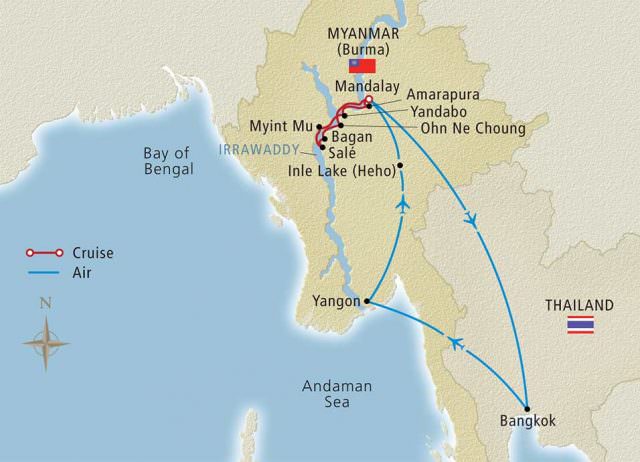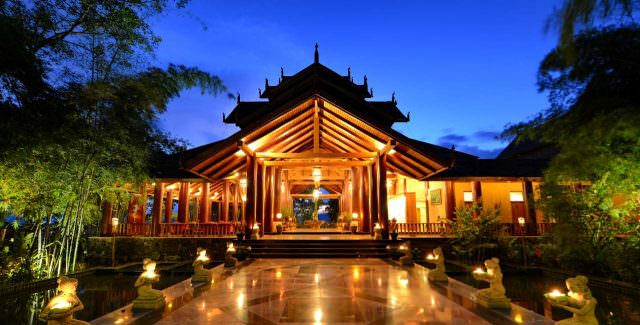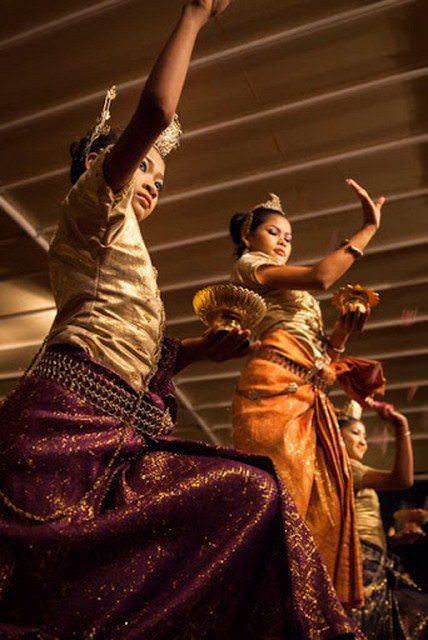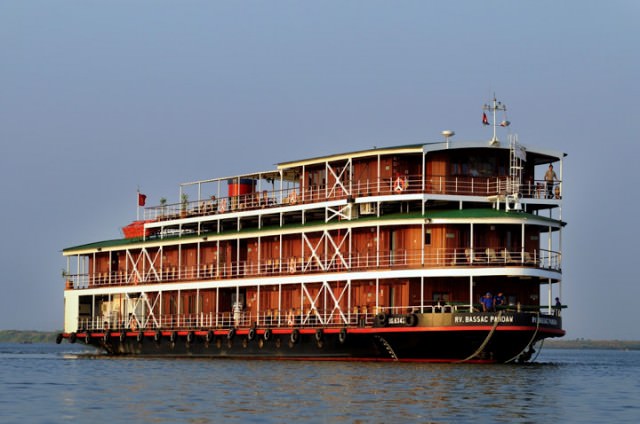Cruising through Mystical, Magical Myanmar with Viking River Cruises
On November 19, I’m embarking on a decidedly unique journey through one of river cruising’s newest (and perhaps most mysterious) new destinations: Myanmar and the Irrawaddy River.
My 15-day Myanmar Explorer journey with Viking River Cruises aboard the 60-guest Viking Mandalay begins with a two-night stay in Bangkok, Thailand at the Shangri-La Bangkok, complete with a guided tour of this vibrant city. I’ve never been to Bangkok before, so I’m excited to see Thailand for the first time.

After two nights, it’s back to the airport to board the flight to Yangon, Myanmar – also known as Rangoon. It’s here that our overland journey begins in Myanmar, with two days of guided touring and two nights at the Sule Shangri-La.

If you have Viking’s printed 2015 brochure, it is at this point that the entire itinerary has been changed since it was printed back in 2014. And that’s not a problem – because the most exciting part of this overland adventure very well may be the two nights spent in Inle Sap Lake at the ethereal-looking Inle Areum Palace Hotel.
Looking like a set straight out of a movie, the Inle Areum Palace Hotel will serve as our base for two straight days, as Viking guides us through the floating villages and gardens of the region, as well as the 1,000 ancient towering spires that make up the Indein Stupa Complex.
From here, we fly to Mandalay to embark the appropriately-named Viking Mandalay for our week-long river cruise along the famous Irrawaddy River.
We’ll visit Ohn Ne Choung, a traditional farming village and community that’s virtually untouched by modern conveniences. We’ll see Mandalay’s U Benin Bridge, the longest teak bridge in the world.
We’ll also call on Bagan for a day. An ancient capital of Myanmar, Bagan is home to over 3,000 ancient monuments, including the ones we’ll see: Shwesandaw Pagoda; the 11th-century Ananda, one of the best-preserved Bagan temples; and the Ananda Oakkyaung Monastery.
It’s off to the Salé Monasteries after that. These 50 monasteries are home to 7,000 residents. The highlight: the intricate Yout-Saun-Kyaung, with its spectacular wood carvings, built in 1882. We’ll also get to explore some British colonial-style houses before returning to the Viking Mandalay.

As our river cruise comes to a close, we’ll stop in Myint Mu and Monywa to visit the Mohnyin Thambuddhei Paya, a massive Buddhist temple originally built in 1303 that contains a very modest number of images of Buddha; 500,000 to be exact. See? Subtle!
Then, it’s back to Bangkok and the Shangri-La for one last night before the return journey to North America the next day.
So what, exactly, is Myanmar?
Sharing a border with India, China and Thailand, Myanmar has a population of roughly 51 million. You might hear it called Burma – the country’s 26-year old name change still isn’t recognized by many nations, including my own country, Canada.
Here’s the quick rundown on Myanmar: it was held under British rule from 1824 until 1948. It became an independent republic on 4 January 1948, and remained that way until 2 March 1962, when the Burmese military seized power in a coup. The military would continue to exercise supreme power over Burma until 1990, when the government held free elections for the first time in 30 years. The year prior, in 1989, Burma’s name was officially changed to Myanmar.
The 1990’s and first decade of the 2000’s were times of change, and change often brings unrest, as it has frequently over the past thirty years. The military junta was finally disbanded in 2011, and Myanmar is embarking on a program of liberal democracy. It’s highly controversial, as some feel that the effect is more that of quasi-military rule. That’s not for me to say. What is clear is that Myanmar’s rich history is, for the first time in nearly a century, gradually being pried open to Western audiences.
Though you may not be as familiar with Myanmar, you may be famous with some of the works that have been written about it that have popularised places like Mandalay, Rangoon, the Irrawaddy and even Myanmar itself.
Famed author Rudyard Kipling visited Myanmar in 1890 – then called Burma – and was so struck by the beauty of the place that he penned one of his most famous poems, Myanmar, as a result of his time there. Though Kipling would make the pagoda in the town of Moulmein famous with his poem, Kipling himself stated that he’d barely even paid attention to it; his singular focus was a pretty Burmese girl sitting on its steps. Though Kipling’s quote on the subject descends into the folksy misogyny of the time (“I will teach her not to defile her pretty mouth with chopped tobacco…”), it’s pretty clear that Kipling had Burmese women on the brain.
To Kipling, Burma was everything that England was not. Burma, even in 1890, was very much an entity unto its own. From the outset, it appears that’s not so far-fetched from what Myanmar is today.
George Orwell was so inspired by his time here that he penned his fiction novel, Burmese Days, in 1934. Although fiction, there’s a lot of evidence to indicate Orwell blended his own personal experiences as an imperial policeman in the country into the resulting story.
I have to be honest and say I know embarrassingly little about Myanmar. I’ve spent over $80 on guide books to better acquaint myself with the country, its customs, and its history. But to be honest, that’s what so attracted me to this cruise. Viking offers a number of exotic itineraries, tucked away at the back of their brochure, including river cruises that explore the treasures of China, Tibet, Vietnam and Cambodia, and Myanmar.
Very little has been written about river cruises here – another great reason to feature this amazing journey as a Live Voyage Report. I use the term “live” rather loosely; I suspect I’ll be forced to post the blogs once I’ve returned to Canada on December 3; I don’t expect the ship or the region to have much in the way of internet connectivity.
Like all of their Asian itineraries, Viking – as with nearly every other cruise line – doesn’t directly own or operate the Viking Mandalay. Instead, they’ve partnered with Pandaw – one of the region’s leading river cruise operators – to handle the technical and hotel side of things. But Viking still retains overall charge of the cruise tour program directors, and Pandaw has tailored the entire product to Viking’s exact specifications.
Couple with that the weeklong overland tour filled with exciting excursions, experiences and first-class hotels, and 15 days exploring Myanmar begins to look like an incredibly exciting journey.
To me, this the epitome of an adventure, and the chance to see a part of Southeast Asia that remains a mystery – or virtually unknown – to many North Americans. It’s rather incredible to think that, in this age of iPhones and internet and round-the-clock connectivity, there are still parts of the world that can be unknown to us.
Myanmar is just one such part – and Viking River Cruises can take you there.
Our full day-by-day Voyage Report from onboard Viking River Cruises’ Viking Mandalay will be published here in early December. If you have any questions for us about this itinerary, ask away – and be sure to follow along with our voyage reports on Twitter @deckchairblog.



Leave a Reply